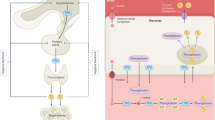Abstract
THERE are certain facts in regard to braxy and braxy-like diseases which strongly suggest that the root of the trouble lies in a temporary lessening of the efficiency of the thyroid gland, and a consequent lowering of the resistance of the body to bacterial invasion from the alimentary tract. If this be true, some preparation of thyroid, or even simple iodine, given to the sheep during the autumn and winter months would prevent serious losses amongst the flocks.
This is a preview of subscription content, access via your institution
Access options
Subscribe to this journal
Receive 51 print issues and online access
$199.00 per year
only $3.90 per issue
Buy this article
- Purchase on Springer Link
- Instant access to full article PDF
Prices may be subject to local taxes which are calculated during checkout
Similar content being viewed by others
References
An excellent summary ot the facts in regard to thyroid is given by McCarrison, “The Thyroid Gland”, 1917. A summary of the facts about braxy is given by: (1) Dakin, W. J., “Beverly Sheep Disease”. Report of Biological Dept., University of Western Australia, 1918. (2) Gaiger, S. H., “Investigations into Braxy”, Animal Disease Research Association (Scotland), Journ. of Pathology and Therapeutics, vol. xxxv. Parts 3 and 4, 1922. (3) McGowan, J. P., “Brachsot or Braxy”, Centralbl. f. Bakt., etc., I. Abt, Originate, Bd. 91, Heft 1. Jena. Sept. 1923.
Author information
Authors and Affiliations
Rights and permissions
About this article
Cite this article
BAMBER, R. An Apparent Connexion between Braxy and Thyroid Activity. Nature 113, 161–162 (1924). https://doi.org/10.1038/113161a0
Issue Date:
DOI: https://doi.org/10.1038/113161a0
Comments
By submitting a comment you agree to abide by our Terms and Community Guidelines. If you find something abusive or that does not comply with our terms or guidelines please flag it as inappropriate.



